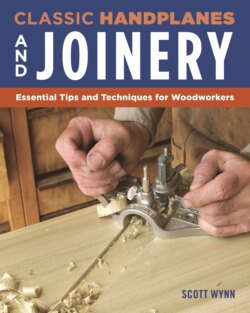Читать книгу Classic Handplanes and Joinery - Scott Wynn - Страница 16
На сайте Литреса книга снята с продажи.
Types of Edge Steel
ОглавлениеSteel for hand tool blades can be roughly divided into two categories: carbon steel and alloyed steel. All tool steels contain carbon, which is what makes it possible to harden the metal. Processed from iron and iron ore, carbon steel contains at least 0.5% carbon, and traces of other elements. Alloyed steel is carbon steel with small amounts of other elements added to improve performance under certain conditions and for certain purposes.
Although manufacturers of steel have specific guidelines with regard to the percentages of alloys used in their steels, and each recipe is identified with a name, manufacturers of woodworking tools, at least until recently, usually chose to ignore the nomenclature. They instead choose to give a broadly descriptive or generic term for the steel that may encompass many different steels of widely varying recipes and characteristics, based on how they perceived the market. One example of a descriptive term like this is “tungsten vanadium.” As it turns out, there are quite a few steels with tungsten and vanadium, each widely varying in their percentage—and performance characteristics. This is in direct contrast to contemporary knife makers who are quite specific about which steel they are using in their blades, such as 12C27, 9Cr13CoMoV, or 440C. Recently, hand tool makers have been a little more specific about what type of steel they use for their blades, such as O-1 and A-2, but this is by no means consistent. If you already have a plane and want to know what kind of steel the blade is, you can put it on the grinder and look up the resulting spark pattern; this will give you a good indication of its general type. Of course, you can also use it and see if it performs as you want it to, in which case it may not make any difference what type it is. If you’re buying or replacing a blade, the following information should help.
